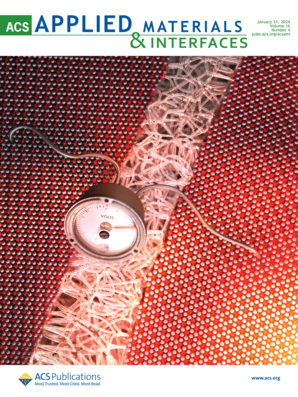用于稳定立方相脂质纳米颗粒的聚集诱导发射活性共聚物,可用于生物成像。
IF 8.3
2区 材料科学
Q1 MATERIALS SCIENCE, MULTIDISCIPLINARY
引用次数: 0
摘要
荧光成像技术已成为生物医学工程和生物材料科学中的一项重要技术。具有聚集诱导发射(AIE)特性的荧光探针由于其光稳定性和灵敏度而成为成像的特殊候选者。然而,AIE官能团的疏水性限制了其广泛的适用性。为了克服这一限制,我们采用AIE方法,将四苯基乙烯(TPE)基团结合到两亲性嵌段和随机共聚物中,这些共聚物具有不同长度的2-(二甲氨基)甲基丙烯酸乙酯(DMAEMA)片段。这些新聚合物在水环境中表现出自组装行为,形成荧光核壳胶束,可以作为含有复杂逆立方(Q2)和六方(H2)中间相的单油质脂质纳米颗粒(MO-based LNPs)的双功能稳定剂。通过合理设计DMAEMA,实现了自组装聚合物胶束和聚合物稳定LNPs两种纳米体系的TPE荧光强度随ph值的增强。新型聚合物稳定LNPs通过共聚焦显微镜在HeLa细胞中成功地进行了荧光成像。该研究首次利用基于TPE和DMAEMA的嵌段共聚物作为LNPs的荧光稳定剂,其荧光强度可通过DMAEMA嵌段长度和环境ph的变化来调节。这些研究结果强调了具有可调物理化学性质的AIE嵌段共聚物对生物系统中纳米材料荧光成像的重要性。本文章由计算机程序翻译,如有差异,请以英文原文为准。
Aggregation-Induced Emission Active Copolymers Designed for Stabilizing Cubic Phase Lipid Nanoparticles That Can Be Used for Bioimaging.
Fluorescence imaging has become a powerful technique in biomedical engineering and biomaterials science. Fluorescence probes exhibiting aggregation-induced emission (AIE) characteristics stand out as exceptional candidates for imaging due to their photostabilities and sensitivities. However, the hydrophobicity of the AIE functional groups limits their broad applicability. To overcome this limitation, we employed AIE by incorporating tetraphenylethylene (TPE) groups into amphiphilic blocks and random copolymers with varying lengths of 2-(dimethylamino)ethyl methacrylate (DMAEMA) segments. These new polymers demonstrate self-assembly behaviors forming fluorescent, core-shell micelles in aqueous environments and can serve as dual-functional stabilizers for monoolein-based lipid nanoparticles (MO-based LNPs) containing intricate inverse cubic (Q2) and hexagonal (H2) mesophases. Through rational design of incorporating DMAEMA, a pH-dependent enhancement in TPE fluorescent intensity for both nanosystems, the self-assembled polymer micelles and polymer-stabilized LNPs, was achieved. Successful fluorescence imaging of the novel polymer-stabilized LNPs was demonstrated in HeLa cells by confocal microscopy. This study represents the first instance of utilizing TPE- and DMAEMA-based block copolymers as fluorescent stabilizers for LNPs, with tunable fluorescent intensities by variations of DMAEMA block length and environmental pH. These findings underscore the significance of AIE block copolymers with tunable physicochemical properties for fluorescence imaging of nanomaterials in biological systems.
求助全文
通过发布文献求助,成功后即可免费获取论文全文。
去求助
来源期刊

ACS Applied Materials & Interfaces
工程技术-材料科学:综合
CiteScore
16.00
自引率
6.30%
发文量
4978
审稿时长
1.8 months
期刊介绍:
ACS Applied Materials & Interfaces is a leading interdisciplinary journal that brings together chemists, engineers, physicists, and biologists to explore the development and utilization of newly-discovered materials and interfacial processes for specific applications. Our journal has experienced remarkable growth since its establishment in 2009, both in terms of the number of articles published and the impact of the research showcased. We are proud to foster a truly global community, with the majority of published articles originating from outside the United States, reflecting the rapid growth of applied research worldwide.
 求助内容:
求助内容: 应助结果提醒方式:
应助结果提醒方式:


